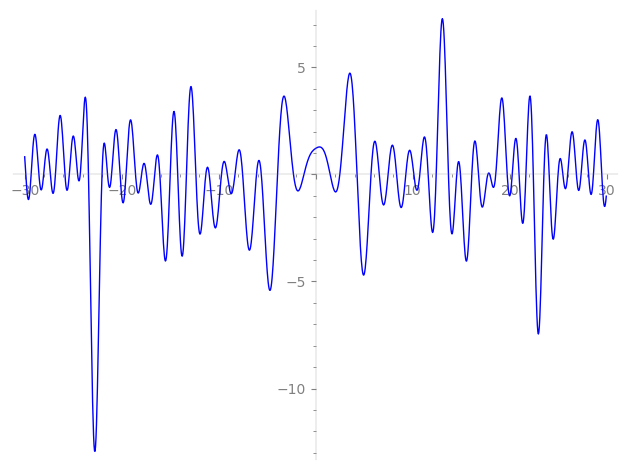| L(s) = 1 | + (−1.40 − 0.127i)2-s + (1.96 + 0.359i)4-s + (1.87 − 1.08i)5-s + (2.55 + 0.669i)7-s + (−2.72 − 0.758i)8-s + (−2.77 + 1.28i)10-s + (1.67 − 2.89i)11-s + 1.74·13-s + (−3.51 − 1.27i)14-s + (3.74 + 1.41i)16-s + (−0.283 + 0.491i)17-s + (−0.270 − 0.467i)19-s + (4.07 − 1.45i)20-s + (−2.72 + 3.86i)22-s + (−5.21 + 3.01i)23-s + ⋯ |
| L(s) = 1 | + (−0.995 − 0.0903i)2-s + (0.983 + 0.179i)4-s + (0.837 − 0.483i)5-s + (0.967 + 0.253i)7-s + (−0.963 − 0.268i)8-s + (−0.877 + 0.405i)10-s + (0.503 − 0.872i)11-s + 0.483·13-s + (−0.940 − 0.339i)14-s + (0.935 + 0.354i)16-s + (−0.0688 + 0.119i)17-s + (−0.0619 − 0.107i)19-s + (0.910 − 0.324i)20-s + (−0.580 + 0.823i)22-s + (−1.08 + 0.627i)23-s + ⋯ |
Λ(s)=(=(504s/2ΓC(s)L(s)(0.881+0.472i)Λ(2−s)
Λ(s)=(=(504s/2ΓC(s+1/2)L(s)(0.881+0.472i)Λ(1−s)
| Degree: |
2 |
| Conductor: |
504
= 23⋅32⋅7
|
| Sign: |
0.881+0.472i
|
| Analytic conductor: |
4.02446 |
| Root analytic conductor: |
2.00610 |
| Motivic weight: |
1 |
| Rational: |
no |
| Arithmetic: |
yes |
| Character: |
χ504(269,⋅)
|
| Primitive: |
yes
|
| Self-dual: |
no
|
| Analytic rank: |
0
|
| Selberg data: |
(2, 504, ( :1/2), 0.881+0.472i)
|
Particular Values
| L(1) |
≈ |
1.18217−0.297126i |
| L(21) |
≈ |
1.18217−0.297126i |
| L(23) |
|
not available |
| L(1) |
|
not available |
L(s)=p∏Fp(p−s)−1 | p | Fp(T) |
|---|
| bad | 2 | 1+(1.40+0.127i)T |
| 3 | 1 |
| 7 | 1+(−2.55−0.669i)T |
| good | 5 | 1+(−1.87+1.08i)T+(2.5−4.33i)T2 |
| 11 | 1+(−1.67+2.89i)T+(−5.5−9.52i)T2 |
| 13 | 1−1.74T+13T2 |
| 17 | 1+(0.283−0.491i)T+(−8.5−14.7i)T2 |
| 19 | 1+(0.270+0.467i)T+(−9.5+16.4i)T2 |
| 23 | 1+(5.21−3.01i)T+(11.5−19.9i)T2 |
| 29 | 1−1.77T+29T2 |
| 31 | 1+(6.56+3.79i)T+(15.5+26.8i)T2 |
| 37 | 1+(−9.60+5.54i)T+(18.5−32.0i)T2 |
| 41 | 1−7.77T+41T2 |
| 43 | 1−1.80iT−43T2 |
| 47 | 1+(−0.679−1.17i)T+(−23.5+40.7i)T2 |
| 53 | 1+(−1.46+2.54i)T+(−26.5−45.8i)T2 |
| 59 | 1+(−9.84−5.68i)T+(29.5+51.0i)T2 |
| 61 | 1+(5.60+9.71i)T+(−30.5+52.8i)T2 |
| 67 | 1+(10.7+6.21i)T+(33.5+58.0i)T2 |
| 71 | 1−7.79iT−71T2 |
| 73 | 1+(−7.56−4.36i)T+(36.5+63.2i)T2 |
| 79 | 1+(4.77+8.27i)T+(−39.5+68.4i)T2 |
| 83 | 1−15.9iT−83T2 |
| 89 | 1+(6.30+10.9i)T+(−44.5+77.0i)T2 |
| 97 | 1−16.4iT−97T2 |
| show more | |
| show less | |
L(s)=p∏ j=1∏2(1−αj,pp−s)−1
Imaginary part of the first few zeros on the critical line
−10.97749760017023383327709798976, −9.713404718850945562050821655329, −9.120996071343508100867969064502, −8.322050786808555257658407551004, −7.53237643263802216040970657624, −6.10600761486083659750138581644, −5.60958808487587870396104085719, −3.94056628900772601888058826694, −2.29237409246094589423192807395, −1.21477577274253163169828381047,
1.48743169964490963109449858606, 2.48294234592600286457171470297, 4.25437052265798851608917101221, 5.69771840658342174857394443914, 6.55109668541690386311842245128, 7.45622736118693583522110370446, 8.337254880331970242355134294595, 9.285757820769499726954715179971, 10.11018214959266827209341129152, 10.72864386639742602945674830570

